St John’s Eve and Midsummer
written by Anne Newman - Thursday, 20th and Friday 28th June 2019, updates 2023
At sunset on 23rd June,
the mid-summer festival begins.
A fire festival known as St. John's
Eve, or Bonfire (Bone-fire) Night, and not that long ago, it was a wide-spread
tradition throughout Ireland. It was traditionally marked by lighting
large fires throughout the countryside as the sun went down. The
fires had to be watched and tended until long after midnight.
Prayers use to be said to obtain God's blessing on the crops. It was mainly women who shared in the prayers for the gardens, crops and for good weather. The prayers were to ensure a plentiful harvest and to make sure "the white trout come up the river" with the mid-summer floods.
Sunday 24 June 2012 - Ramparts, Navan - Trust in the Universe On the ridge path between the fast flowing river and sluggish canal we found a wonderful gnarled tree, its trunk alive with different animals - like a totem pole in the woods. Symbolically uniting above & below, each wrote their personal wish on a star... Recognising
the unknown and unseen within our personal intentions, we dipped
into the depths of a bag, taking a pinch of oats and wheat which we
then released to the earth. Anne reminded us of the quote from Rumi - "Everything you see has its roots in the unseen world." True of Navan - an Uaimh - often translated as 'the cave' | 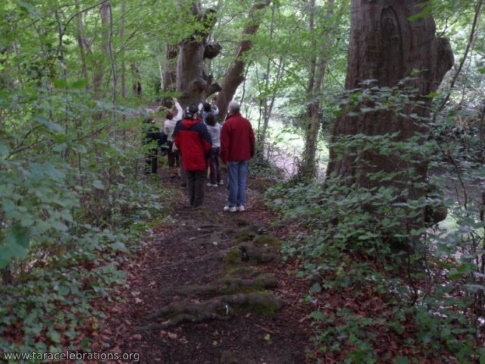 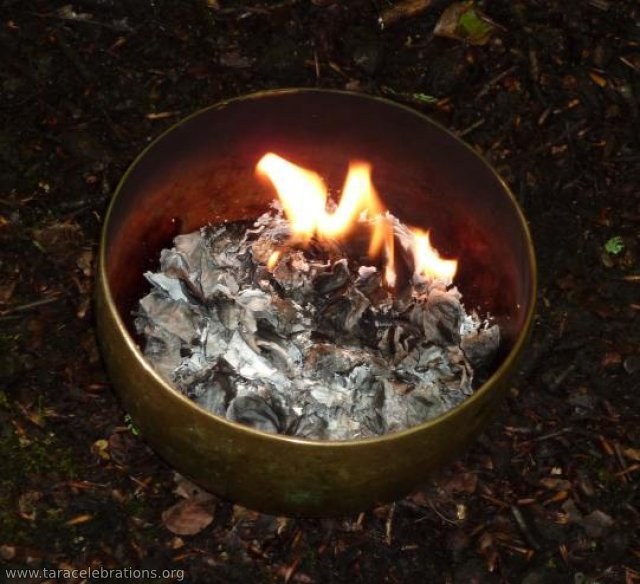 We burnt the written intentions and released the ashes to the river, combining the vital elements of fire and water. |
The fire itself was thought to have magical powers. Burning weeds in its flames would prevent arable fields from becoming overgrown, while scattering it's ashes on the fields would guarantee the land’s fertility.
In some
places the young men would march through the fields with lighted
branches from the bonfire to protect the crops from disease and
pestilence.
In others the young men used to walk through the fields with lighted torches and then cast these into the fire to bring a blessing on the fields and protect the crops from harm. Different customs but the same underlying theme.
Anne was in Donegal for the 21st June 2022 and Sunset fires lit up across the land
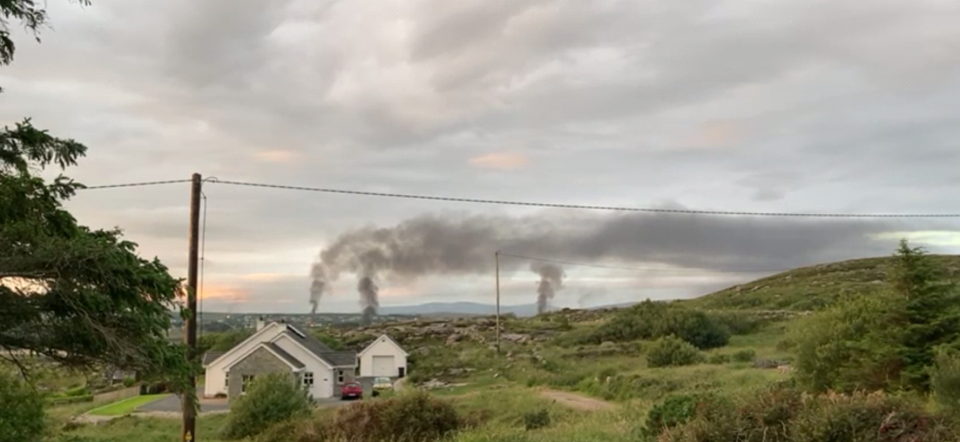
It was considered lucky
to bring some ashes home to light the kitchen hearth.
Another custom was that rosary beads, little statues or scapulars, when they became broken or worn out were destroyed without disrespect by being burned in the Midsummer Fire.
People gathered to dance and sing, stories were told, and young men proved their bravery by leaping through the flames.
Although most of these customs are no longer practised, lighting St. John’s bonfires still takes places in many parts of Ireland. It is hardly a coincidence that these fires are lit so close to the Summer Solstice and it suggests that the custom may have ancient roots.
From the Duchas School's collection - a bon fire at the cross roads.
On bon fire night June 24, they used to have a bon fire at the cross roads. All the boys and girls used to jump over it and dance around it. At 12 oclock they would return home carrying a piece of stick from the bon fire to throw over their garden and while doing this they used to pray.
This was always a great night in Carrigaline, as it is the night before the feast of their patron St, St John. There is also a well dedicated to St John in the parish. On this night visits were made to the well. On St John's Sunday all the natives who were in other parishes used to return to Carrigaline and visit the well.
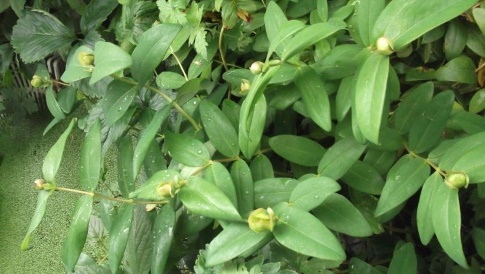
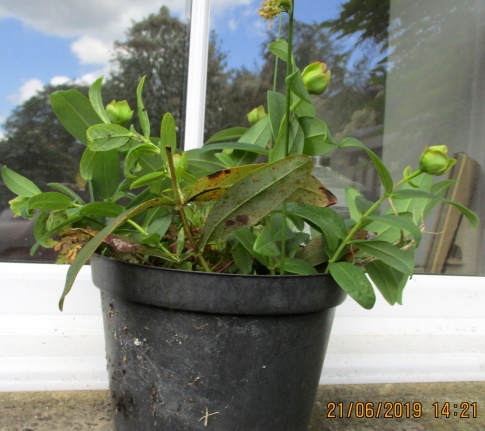
In most fishing districts, St. John's Day was important as it was the day the boats and nets were blessed. On the rivers, anglers eagerly anticipated the arrival of sea trout which came up the rivers at this time of year.
Unless the weather proved too cold, summer swimming began on St. John's Day and the observance of the festival was supposed to eliminate all danger of drowning.
Overall though, it was a time of optimism, with farmers hoping they'd get a period of wet weather before St. John's Day and dry weather afterwards. This year we are certainly getting the rain beforehand!
Traditionally, women
gathered herbs on St. John's Eve. These vary from area to area, but
on the Feast of St. John, it is customary to gather the perennial
herb St. John’s Wort (hypericum), which flowers at this time and has many uses. The herb is hung over windows and doors for protection. However,
The wort weed or St. John's Wort is a great enemy of the farmer because it grows very thickly in gardens and spoils the crop of potatoes. Herbs - Co. Clare
Yarrow is also in flower and has been used since ancient times for healing wounds, and it's essential oil has anti-inflammatory properties. Yarrow was also used as a ward against evil, and traditionally it was burned on the Eve of St John's Day.
24th June - Midsummer's Day. Little Trinity. St John the Baptist Feast Day.
St. John's Day is also important in Europe.
In ENGLAND, the feast of St. John the Baptist, is one of the quarter days.
On JERSEY the day is known as "Les cônes d'la Saint Jean" and was observed as late as the 1970s - horns or conch shells were blown. Ringing the bachîn (a large brass preserving pan) at midsummer to frighten away evil spirits survived as a custom on some farms until the 1940s and has been revived as a folk performance in the 21st century.
In FRANCE, the "Fête de la Saint-Jean" is celebrated with bonfires. In the Vosges region and in the Southern part of Meurthe-et-Moselle, this huge bonfire is named "chavande".
In ITALY Saint John the Baptist is the patron saint of Genoa, Florence and Turin where a fireworks display takes place during the celebration on the river. In Turin Saint John's following is well-established since medieval times and the city stops work for two days and people from the surrounding areas gather to dance around the bonfire in the central square. In Genoa and coastal Liguria it is traditional to light bonfires on the beaches on Saint John's Eve to remember the fires lit to celebrate the arrival of Saint John's relics to Genoa in 1098. Since 1391 on the 24th June a great procession across Genoa carries the relics to the harbour, where the Archbishop blesses the city, the sea, and those who work on it.
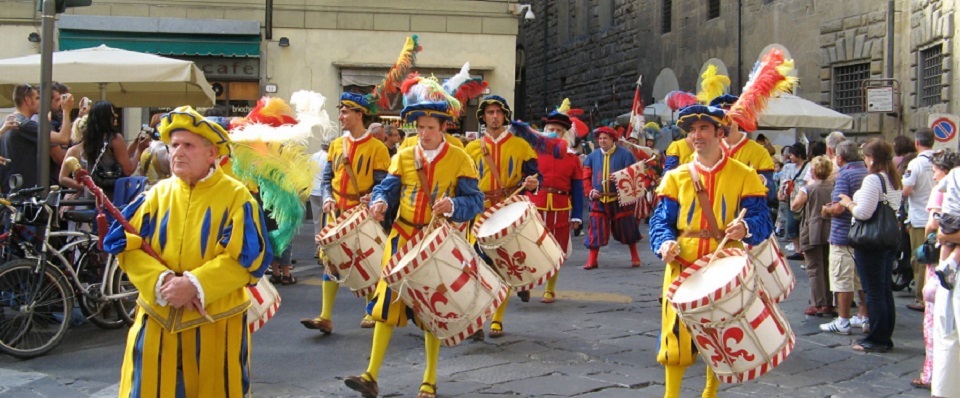
In GERMANY it is celebrated as Sommersonnenwende.
In GREECE it is called Klidonas (Κλήδονας) meaning sign or oracle, and was considered a time when unmarried girls would discover their potential partners through a ritual.
HUNGARY celebrates "Saint Ivan's Night" , and in ROMANIA the Midsummer celebrations are named Drăgaica or Sânziene. Drăgaica is celebrated by a dance performed by a group of 5–7 young girls of which one is chosen as the Drăgaica. She is dressed as a Bride, with wheat wreath, while the other girls, dressed in white wear a veil with bedstraw flowers.
In PORTUGAL there are St John's street parties in many cities, towns and villages, mainly between the evening on the 23rd and St.John's Day on the 24th June. Bonfires are lit on the beaches and there atre alos fireworks. one of the biggest festivals is held. At Porto, Festa de São João do Porto, after the bonfire and fireworks, many head for the sea. They wait for the sunrise, and some swim in the ocean as the sun rises.
This midsummer tradition is especially strong in north-western areas of SPAIN, especially in Galacia, where San Xoán festivals take place all over the region; bonfires are lit and firework displays usually take place. On the Mediterranean coast, bonfires are lit on the beaches in Catalonia and Valencia, special foods, such as Coca de Sant Juan, are also served on this occasion. A sweet or savoury pastry.
| Coca de Sant Juan, aka Coca de Sant Joan, or St. John’s Cake | 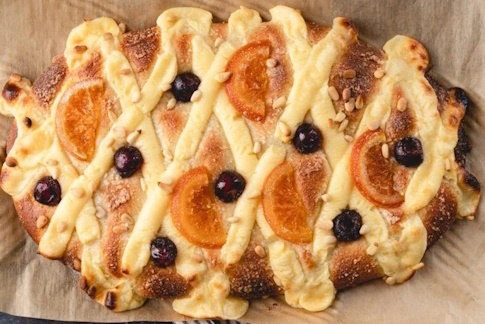 |
ESTONIANS celebrate "Jaaniõhtu" with bonfires. On the islands of Saaremaa and Hiiumaa, old fishing boats may be burnt in the large pyres set ablaze.
In POLAND the festival is known as 'sobótki'. Traditional folk rituals include groups of young men and women singing ritual songs to each other. The young women may wear crowns fashioned from wild flowers, which are later thrown into a nearby pond or lake. The boys/young men may then swim out to claim one of the crowns. Bonfires (and bonfire jumping) are also part of the proceedings.
In NORWAY, as elsewhere
in Scandinavian countries, this event is celebrated with a communal
bonfire. The event is also known as Jonsok, meaning "wake of
Saint John".
It is known as Midsommar in SWEDEN. Originally a pre-Christian tradition, now influenced by Christian traditions and the celebration of Saint John, . A central symbol nowadays is the 'midsummer pole', a high wooden pole covered in leaves and flowers that is raised on the same day as midsummers eve. . A Saint John’s Eve custom involves people visiting Holy wells as "a reminder of how John the Baptist baptised Christ in the River Jordan."
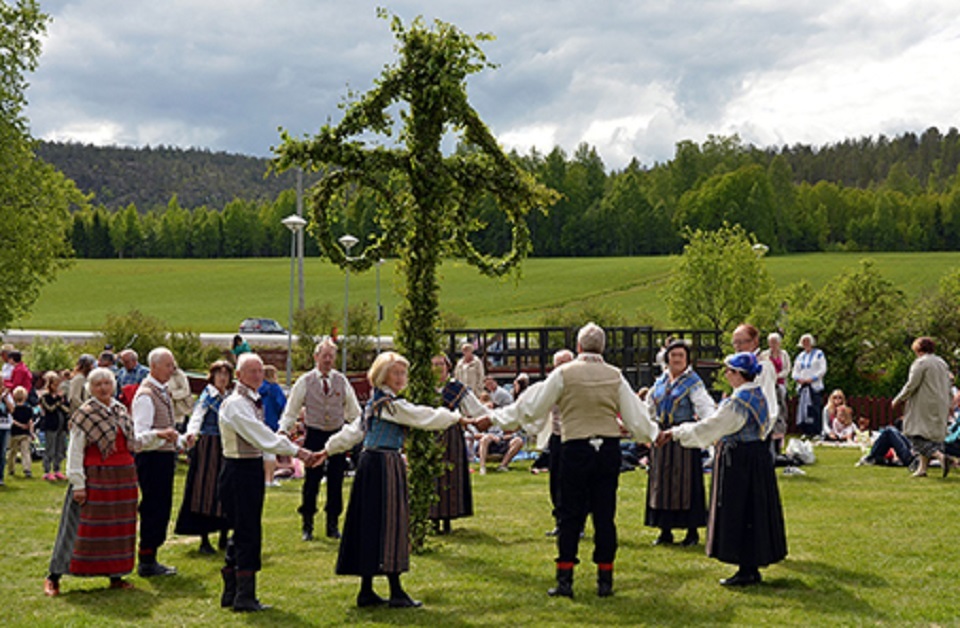
In FINLAND the summer solstice was called Ukon juhla ("Ukko's celebration") after the Finnish god Ukko. Later the celebrations became known as 'juhannusafter', John the Baptist. Traditions include being close to nature with family and friends, going to a sauna and swimming in the lake or sea, and watching a bonfire.These were believed to frighten evil spirits and demons away. Dinner is typically barbecue or salmon with dill and new potatoes, and fresh strawberries for dessert.
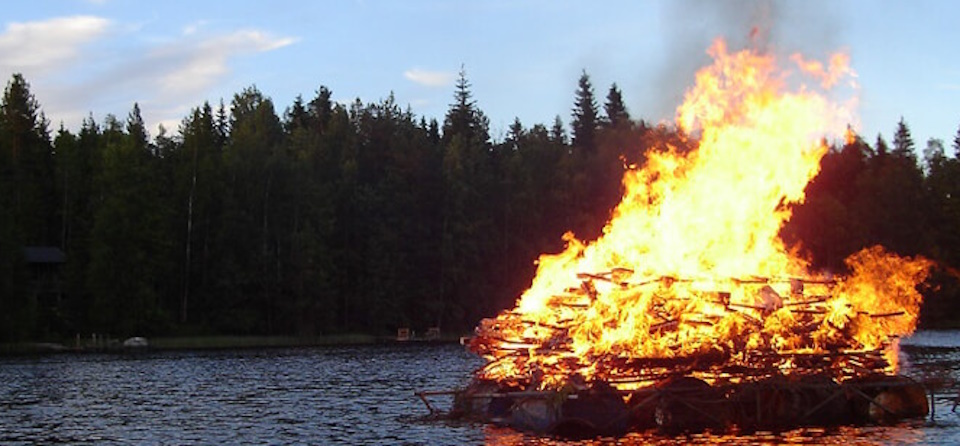
ISLE OF MAN. This was John the Baptist's Feast Day, Laa’l Ean Bashtey. or Little Trinity, Trinaig Veg. Midsummer Fair (or Little Trinity Fair) was held at Sulby Claddaghs, Lezayre.
At Barrule, well into the 19th century, bundles of grass were laid down for the Celtic God of Man & Arran, Manniman-beg-mac-y-Lear, who appeared as a heron and would be seeking women to court.
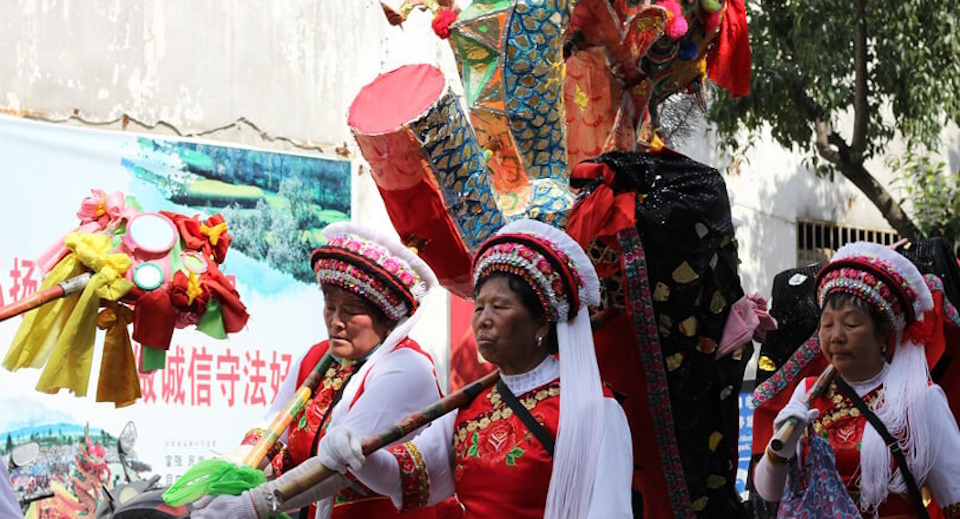
Yi Torch Festival in Yunnan, China
Held on the 24th to the 25th days of the sixth month of Chinese lunar calendar. For three days, torches burn outside homes and light up the hills as bearers walk in the surrounding area.
For the Naxi, the festival commemorates a general from heaven who died in order to protect people’s grain harvests; the Lisu people think the festival was for welcoming Zhuge Liang’s expedition to the south, and the torch was to drive away the diseases and beasts on the way forward; the Yi people celebrate the festival to eradicate insect swarms and celebrate a good harvest; while the Sani people, a branch of the Yi ethnic group, believe that the festival is held to commemorate a Sani hero who burned the fiend with a goat horn. The fiend used to bully Sani people.





